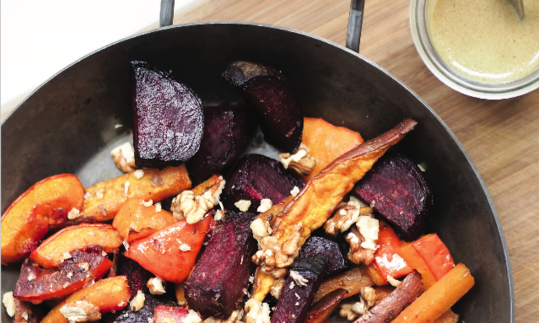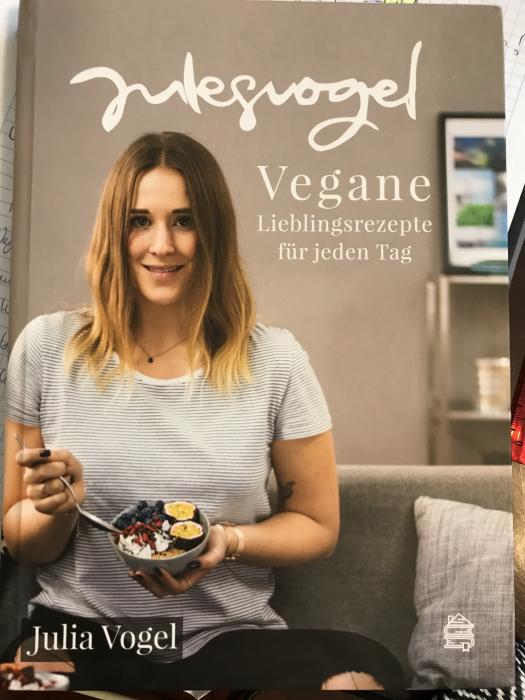Roasted Vegetables with Red Beet, Pumpkin, and Mustard Sauce
vegan
Ingredients (for serving, )
| For the roasted vegetables | |
|---|---|
| 1 | Beetroot, raw (organic?) (5.5 oz) |
| 11 oz | Hokkaido pumpkins (Hokkaido pumpkins) |
| 2 | Carrots (carrots), raw (organic?) (4.3 oz) |
| ½ | Sweet potato, raw (sweet potato, white potato) (2.3 oz) |
| ½ tbsp | Rapeseed oil (canola, HOLL oil, kernel oil), cold pressed?, organic? (0.25 oz) |
| ½ tsp | Paprika powder, hot (raw?, organic?) (0.04 oz) |
| 1 dash | Table salt (table salt, raw?, organic?) (0.01 oz) |
| For the mustard sauce | |
| 2 tbsp | Mustard (Mostert, Mostrich, raw?, organic?) (0.88 oz) |
| 1 tbsp | Agave syrup (agave syrup, raw?, organic?) (0.41 oz) |
| ½ tbsp | Rapeseed oil (canola, HOLL oil, kernel oil), cold pressed?, organic? (0.25 oz) |
| 1 tbsp | Balsamic vinegar (Aceto balsamico, raw?, organic?) (0.56 oz) |
| 2 tbsp | Drinking water, raw (organic?) (0.40 oz) |
| Topping | |
| ⅞ oz | Walnuts (tree nuts), raw (organic?) |
Equipment
- oven
- casserole dish (baking dish)
Type of preparation
- bake
- chop or grind
- marinate
Preparation
For the roasted vegetables
Preheat the oven to 200 °C. Wash and dice the red beet, pumpkin, carrots, and sweet potatoes.The original recipe for 1 serving calls for ¼ Hokkaido pumpkin and a red beet about the size of a fist.
Toss the prepared vegetables with the canola oil, ground paprika, and salt. Then bake in the oven for 30–40 minutes.
We have reduced the salt from ¼ teaspoon to a dash and replaced the 1 tablespoon of olive oil with ½ tablespoon canola oil (see Alternative Preparation).
For the mustard sauce
In the meantime, mix all of the ingredients for the mustard sauce and coarsely chop the walnuts.The author also uses 1 tablespoon olive oil for the sauce; we have instead chosen to use ½ tablespoon canola oil.
The original recipe calls for a handful of walnuts.
Arrange and serve
Let the roasted vegetables cool briefly and then serve with the sauce and chopped walnuts.
|
Nutritional Information per person
Convert per 100g
|
2000 kcal | |
|---|---|---|
| Energy | 631 kcal | 31.5% |
| Fat/Lipids | 32 g | 46.2% |
| Saturated Fats | 2.8 g | 14.1% |
| Carbohydrates (inc.dietary fiber) | 83 g | 30.6% |
| Sugars | 37 g | 41.1% |
| Fiber | 17 g | 69.3% |
| Protein/Albumin | 13 g | 25.0% |
| Cooking Salt (Na:690.1 mg) | 1'753 mg | 73.0% |
| Essential micronutrients with the highest proportions | per person | 2000 kcal | |
|---|---|---|---|
| Vit | Vitamin A, as RAE | 2'059 µg | 257.0% |
| Fat | Alpha-Linolenic acid; ALA; 18:3 omega-3 | 3.8 g | 188.0% |
| Vit | Vitamin B9, B11 (Folate, as the active form of folic acid) | 302 µg | 151.0% |
| Fat | Linoleic acid; LA; 18:2 omega-6 | 13 g | 126.0% |
| Elem | Potassium, K | 2'358 mg | 118.0% |
| Min | Manganese, Mn | 2.3 mg | 117.0% |
| Min | Copper, Cu | 0.91 mg | 91.0% |
| Sodium, Na | 690 mg | 86.0% | |
| Vit | Vitamin B6 (pyridoxine) | 1.1 mg | 77.0% |
| Prot | Threonine (Thr, T, irreversibly transaminated) | 0.68 g | 74.0% |
Detailed Nutritional Information per Person for this Recipe
The majority of the nutritional information comes from the USDA (US Department of Agriculture). This means that the information for natural products is often incomplete or only given within broader categories, whereas in most cases products made from these have more complete information displayed.
If we take flaxseed, for example, the important essential amino acid ALA (omega-3) is only included in an overarching category whereas for flaxseed oil ALA is listed specifically. In time, we will be able to change this, but it will require a lot of work. An “i” appears behind ingredients that have been adjusted and an explanation appears when you hover over this symbol.
For Erb Muesli, the original calculations resulted in 48 % of the daily requirement of ALA — but with the correction, we see that the muesli actually covers >100 % of the necessary recommendation for the omega-3 fatty acid ALA. Our goal is to eventually be able to compare the nutritional value of our recipes with those that are used in conventional western lifestyles.
| Essential fatty acids | per person | 2000 kcal |
|---|---|---|
| Alpha-Linolenic acid; ALA; 18:3 omega-3 | 3.8 g | 188.0% |
| Linoleic acid; LA; 18:2 omega-6 | 13 g | 126.0% |
| Essential amino acids | per person | 2000 kcal |
|---|---|---|
| Threonine (Thr, T, irreversibly transaminated) | 0.68 g | 74.0% |
| Tryptophan (Trp, W) | 0.17 g | 70.0% |
| Isoleucine (Ile, I) | 0.58 g | 46.0% |
| Valin (Val, V) | 0.66 g | 41.0% |
| Phenylalanine (Phe, F) | 0.60 g | 39.0% |
| Leucine (Leu, L) | 0.91 g | 38.0% |
| Lysine (Lys, K, irreversibly transaminated) | 0.60 g | 32.0% |
| Methionine (Met, M) | 0.21 g | 22.0% |
| Vitamins | per person | 2000 kcal |
|---|---|---|
| Vitamin A, as RAE | 2'059 µg | 257.0% |
| Vitamin B9, B11 (Folate, as the active form of folic acid) | 302 µg | 151.0% |
| Vitamin B6 (pyridoxine) | 1.1 mg | 77.0% |
| Vitamin C (ascorbic acid) | 56 mg | 70.0% |
| Vitamin K | 35 µg | 47.0% |
| Vitamin B1 (Thiamine) | 0.42 mg | 38.0% |
| Vitamin E, as a-TEs | 4.6 mg | 38.0% |
| Vitamin B2 (Riboflavin) | 0.45 mg | 32.0% |
| Vitamin B5 (Pantothenic acid) | 1.9 mg | 32.0% |
| Vitamin B7 (Biotin, ex vitamin H) | 15 µg | 30.0% |
| Vitamin B3 (Niacin) | 4.2 mg | 26.0% |
| Essential macroelements (macronutrients) | per person | 2000 kcal |
|---|---|---|
| Potassium, K | 2'358 mg | 118.0% |
| Sodium, Na | 690 mg | 86.0% |
| Phosphorus, P | 325 mg | 46.0% |
| Magnesium, Mg | 164 mg | 44.0% |
| Calcium, Ca | 216 mg | 27.0% |
| Essential trace elements (micronutrients) | per person | 2000 kcal |
|---|---|---|
| Manganese, Mn | 2.3 mg | 117.0% |
| Copper, Cu | 0.91 mg | 91.0% |
| Iron, Fe | 5.2 mg | 37.0% |
| Zinc, Zn | 2.7 mg | 27.0% |
| Selenium, Se | 13 µg | 23.0% |
| Iod, I (Jod, J) | 4.5 µg | 3.0% |
| Fluorine, F | 12 µg | < 0.1% |
Vegan Favorite Recipes for Every Day by Julia Vogel contains simple, quick recipes for vegans and all those who are just looking for variety.
Since this book is written in German, a description is omitted here. If you are interested, please switch to German in the menu.
Roasted Vegetables with Red Beet, Pumpkin, and Mustard Sauce is not just bright and colorful; it also contains many healthy ingredients.
Nutritional profile: According to GDA guidelines, one serving of this recipe covers the recommended daily requirement for vitamin A, folate (folic acid), potassium, manganese, and the two essential fatty acids ALA and LA. It is particularly noteworthy that this recipe contains lots of healthy fiber and amounts of vitamin A and folate that are much higher than the recommended daily requirement. And at 3:1, the ratio of omega-6 to omega-3 fatty acids is well balanced in this recipe.
Hokkaido pumpkin: Unlike most other pumpkins, the skin of a small Hokkaido pumpkin (1–2 kg) can be eaten and doesn’t need to be peeled. This is because it softens when it is cooked. Hokkaido pumpkin has a firm consistency, is low in fiber, and has a slightly nutty flavor. The orange color comes from the large amount of beta-carotene it contains, which our body can convert into vitamin A. It also has high amounts of vitamins B1, B2, and B6; vitamins C and E; as well as folic acid, magnesium, iron, and phosphorus.
Red beets: Red beets are rich in antioxidants and have anti-inflammatory properties. However, red beets lose some of their nutritional value when cooked.
Sweet potatoes: Sweet potatoes, called yams in parts of North America, are not actually potatoes. While they grow as underground tubers, in contrast to regular potatoes they are not part of the nightshade family. Sweet potato leaves are edible and are a food staple in many tropical countries. Sweet potatoes have a high water content and as such can’t be stored for long periods of time like regular potatoes. However, careful handling (e.g., avoiding bruises) can extend the storage life. A large variety of both sweet and savory dishes can be prepared using sweet potatoes.
These tubers are available in a range of colors, including yellow with red skin, orange-red with reddish-brown skin, and white with light-colored skin.
Selecting Hokkaido pumpkins: If you tap on a Hokkaido pumpkin and it sounds hollow, this is a good sign, especially if the stem is slightly dry but otherwise intact.
This means that the pumpkin is ripe. The stem and skin should be intact.
Avoiding staining: When preparing the beets, you may want to wear gloves in order to prevent your hands from being stained a reddish, violet color.
Olive oil versus canola oil: Economic powers and lobbyists have made olive oil the oil of choice even though canola oil, for example, contains three times more omega-3 fatty acids. In this recipe, we have therefore replaced the olive oil with canola oil. Either way, you should only use cold-pressed oils. Dr. Dean Ornish and other American health researchers recommend avoiding oil in as much as is possible. For this reason, we have also reduced the overall amount of oil. Further information can be found under the ingredient olive oil.




